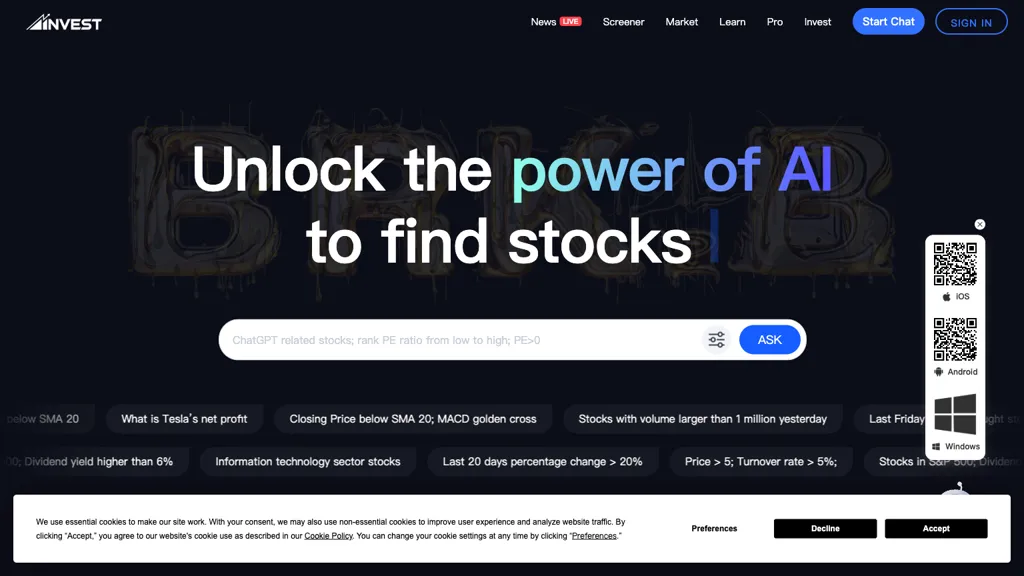When you are evaluating AI trading platforms that predict/analyze the market, coverage of the stock is a key aspect to take into consideration. It determines which assets and markets are readily available. With a platform that provides extensive coverage, you are able to diversify your portfolio and take advantage of opportunities across the globe. You can also adjust to various trading strategies. Here are 10 best tips to help you evaluate the market coverage provided by these platforms.
1. Evaluate Supported Asset Classes
Stocks: Make sure the platform is able to cover major stock exchanges (e.g., NYSE, NASDAQ, LSE, HKEX) and also includes small-cap, large-cap and mid-cap stock.
ETFs: Check if the platform supports a wide range of ETFs for diversified exposure to different regions, sectors or even themes.
Options and Futures: Check if the platform supports derivatives, such as options or futures, as well as other products with leverage.
Commodities and Forex: Find out if the platform supports the forex pair, precious metals, energy commodities and agricultural products.
Cryptocurrencies: Find out if the platform supports major cryptocurrencies (e.g., Bitcoin, Ethereum) and altcoins.
2. Check Coverage Area
Global markets: Make sure that the platform covers major international markets, such as North America, Europe, Asia-Pacific, and emerging markets.
Regional focus: Find out whether your platform has a specific market or market that is compatible with your trading needs.
Local exchanges - Check to find out if there are local or regional exchanges available in relation to your location and your strategy.
3. Compare Real-Time Data with Delayed Data Delayed Data
Real-time Data: Be sure that the platform provides real-time information for trading, and also for making quick decisions.
Delayed data - Check whether delayed data is available for free or is available at a lower cost. This might be enough for investors who are looking to invest for the long term.
Data latency: Check whether the platform reduces latency for data, particularly in high-frequency trading.
4. Analyze historical data availability
In depth of Historical Data: Make sure the platform offers extensive historical data for backtesting, analysis and testing (e.g. 10or more years).
Check the level of precision in historical data.
Corporate actions - Verify previous data to confirm that it covers stock splits, dividends as well as other corporate activities.
5. Check market depths and order books
For better price discovery make sure that the platform includes Level 2 information.
Spreads for bids: See if the platform shows real-time bid-ask spreads for accurate prices.
Volume data: Find out if your platform provides specific volume data for analyzing liquidity and market activity.
6. Check the extent of coverage for Indices and Sectors
Major indices : Make sure you are using a platform that contains the major indexes. (e.g. S&P 500, NASDAQ 100, FTSE 100 ) This is crucial to benchmark your strategy and also for index-based strategies.
Sector-specific data: Check whether the platform offers data for specific sectors (e.g. technology, healthcare, energy) to conduct a targeted analysis.
Custom indices. Determine if your platform permits you to create and monitor custom indexes based on the criteria that you specify.
7. Integrate News and Sentiment Data
News feeds: Ensure the platform integrates live news feeds of reputable sources (e.g., Bloomberg, Reuters) to track market-moving events.
Sentiment analysis Find out whether your platform offers sentiment analysis tools that utilize social media data, news sources, or any other data source.
Strategies based on events: Check whether the platform is compatible with event-driven trading strategies (e.g., earnings announcements, economic reports, etc.).
8. Verify Multi-Market Trading Capability
Cross-market trading: Make sure that the platform is able to trade across multiple markets and asset classes from one interface.
Conversion of currencies: Find out if the platform allows multi-currency trading and automatic conversion of currencies for international trade.
Support for time zones: Find out whether your platform permits you to trade in multiple time zones.
9. Assessment of Alternative Data sources
Alternative data: To get unique insights, verify if the platform incorporates alternative sources of data.
ESG data. Check if the platform is stocked with socio-economic, environmental, and governance information for socially accountable investing.
Macroeconomic data: Ensure that the platform offers macroeconomic indicators that can be used to analyze fundamental issues (e.g. GDP, inflation rates, rate of interest).
10. Review Market Feedback and User Reviews. Reputation
User reviews: Study reviews from users to assess the platform's market coverage and the reliability.
Industry reputation Check whether there are awards or experts who recognize the platform for its coverage of the market.
Case studies and testimonials They will showcase the performance of the platform in particular market segments or asset classes.
Bonus Tips:
Trial time: You can try a demo, trial or a free trial to check the market coverage and the quality of data.
API access - Verify whether the API is able to access information on the market in a programmatic manner.
Customer Support: Ensure that the platform is able to offer support for any data-related or market-related issues.
By following these tips to evaluate the market coverage offered by AI trading platforms that predict or analyze stocks and ensure that you select the one that gives you access to the markets and information you need for successful trading. Comprehensive market coverage enables investors to diversify their portfolios, look for new opportunities and be able to adapt to the changing market conditions. Take a look at the recommended find out more for ai investing app for website info including ai for stock trading, options ai, ai stock trading bot free, best ai trading software, ai trading, best ai stock, ai trading tools, ai for investing, best ai stock, ai investment platform and more.

Top 10 Tips On Assessing The Risk Management Of Ai Stock Forecasting/Analyzing Trading Platforms
Risk management plays a crucial function in any AI-powered platform for trading stocks. It safeguards your investment by limiting the risk of losses and assists you in maximizing profits. A platform with robust risk management tools will aid you in managing volatile markets, and make informed choices. Here are the 10 best strategies for evaluating these platforms' risk management capabilities:
1. Evaluation of Stop-Loss and Take-Profit Features
Level that you can customize: You should be able to customize the stop-loss/take-profit levels of specific strategies and trades.
Make sure to check the platform whether it is compatible with trailing stopped, which will adjust automatically as the market shifts your way.
Check if your platform allows you to make stop-loss orders that guarantee the closing of the trade at the amount specified, even on volatile markets.
2. Tools to Measure Positions
Fixed amount: Ensure the platform allows you to determine the size of your position based on an amount that is fixed in monetary terms.
Percentage in your portfolio Manage your risk by determining position sizes proportionally as per percentage.
Risk-reward percentage: Examine whether you are able to define the risk-reward percentages for specific strategies or trades.
3. Look for Diversification Support
Multi-asset trading: Make sure the platform permits you to trade across different types of assets, including stocks, ETFs as well as options. This can help you diversify your portfolio.
Sector allocation: Verify whether the platform has tools to monitor and manage sector exposure.
Geographic diversification: Make sure that the platform for trading supports international markets in order to spread risk geographically.
4. Review leverage control and margins.
Margin requirements: Ensure the platform discloses clearly any limitations on margins when trading leveraged.
Find out the limitations on leverage. You can use this feature to control the risk you take.
Margin calls: Ensure that you receive prompt messages from the platform to ensure that your account is not liquidated.
5. Review the risk Analytics Reporting
Risk metrics - Make sure that your platform includes important risk indicators like the Sharpe ratio (or Value at Risk (VaR)), or drawdown (or value of portfolio).
Analysis of scenarios: Make sure that the platform is able to create different scenarios for the market to determine the risks.
Performance reports: Check whether you can obtain detailed performance reports from the platform, which include the risk-adjusted outcomes.
6. Check for Real-Time Risk Monitoring
Portfolio monitoring: Ensure the platform offers real-time monitoring of the risk exposure to your portfolio.
Alerts & notifications: Verify the ability of the platform to send real-time warnings of situations that could be risky (e.g. breaches of margins or stop loss triggers).
Risk dashboards – Check to see if the platform you are using offers customizable risk dashboards. This will provide you with more information about the risks that you face.
7. Evaluation of Stress Testing and Backtesting
Stress testing: Ensure that the platform you use allows you to test your strategies or portfolio under the most extreme market conditions.
Backtesting Check if platform supports backtesting with historical data for assessing the risk and performance.
Monte Carlo Simulations: Check whether the application uses Monte Carlo simulations in order to assess and model various possible results.
8. Review Compliance Risk Management Regulations
Ensure that the platform meets the requirements for regulatory compliance (e.g. MiFID II regulations in Europe, Reg T regulations in the U.S.).
Best execution: Make sure that the platform is in line with best execution practices. This will ensure that trades are executed according to the best price available in order to reduce loss.
Transparency: See if the platform provides clear and transparent disclosures of risks.
9. Check for User-Controlled Parameters
Customized risk rules: Check that your platform allows you create custom risk management guidelines (e.g. maximum daily loss or maximum size of the position).
Automated risk control: Ensure that the platform enforces the risk management guidelines automatically based upon your predefined requirements.
Manual overrides: Check whether the platform supports manual overrides of automated risk control in the event of emergencies.
Review user feedback and case research
User reviews: Conduct user research to assess the platform’s efficiency in risk management.
Case studies: Search for testimonials or case studies that highlight the platform's capabilities in the field of risk management.
Community forums - Check to see if the website offers a user community which is active and where traders are able to share their risk management strategies.
Bonus Tips:
Trial period: Try the demo or trial version for free to try out the features of the platform for risk management in real-world scenarios.
Customer support: Make sure your platform has a robust support to any questions or concerns related to managing risk.
Educational resources - Find out whether the platform offers educational resources and tutorials on risk management best practice.
Follow these tips to assess the risk-management capabilities of AI trading platforms that can predict or analyze stock prices. Choose a platform that offers a high quality of risk-management and you'll be able to minimize your losses. Tools for managing risk that are reliable are vital for trading in volatile markets. Follow the most popular use this link on ai stock price prediction for more examples including trading ai tool, best ai stock prediction, how to use ai for stock trading, ai options trading, ai in stock market, how to use ai for stock trading, free ai tool for stock market india, ai options, investing with ai, best ai stock prediction and more.
